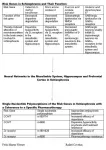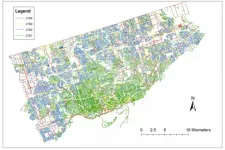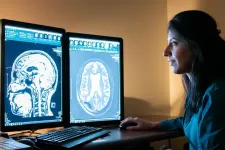UIC researchers find new biomarker for active sarcoidosis
2021-02-25
(Press-News.org) Low blood levels of immune cells called lymphocytes, in combination with higher levels of inflammation on PET/CT scans, are indicators of active sarcoidosis -- an inflammatory disease that attacks multiple organs, particularly the lungs and lymph nodes -- which disproportionately affects African Americans. The discovery by researchers at the University of Illinois Chicago could help guide disease treatment. Their findings are published in the journal Frontiers in Medicine.
The researchers were looking for biomarkers -- both in the blood and in PET/CT scan findings -- that would cluster patients into groups based on disease activity. Symptoms of sarcoidosis can come and go and the disease can switch from active -- where granulomas form and enlarge -- to inactive states where the disease is dormant and symptoms may lessen. There are few tests that can determine whether sarcoidosis is in the active or inactive stage.
"Having a biomarker signature that indicates active inflammation could be very useful in helping guide treatment and for helping us understand the underlying mechanisms associated with the disease," said Dr. Nadera Sweiss, professor of medicine and chief of the department of rheumatology in the UIC College of Medicine and corresponding author of the paper.
The researchers looked at the medical records of 58 patients -- mostly African American -- who were diagnosed with sarcoidosis based on biopsy results and who also underwent PET/CT scanning at the Bernie Mac Sarcoidosis Translational Advanced Research (STAR) Center at UI Health, the academic health enterprise of UIC. These patients all had blood tests that included lymphocyte counts. PET/CT scans provide images that show where active inflammation is occurring in the body.
The researchers found three distinct patient segments that could be grouped based on shared characteristics from lymphocyte counts and PET/CT scan findings. The first group included patients with chronic but quiescent -- dormant -- disease. Group two included mostly African American patients with some markers of general inflammation as seen on PET/CT scans who also had advanced pulmonary disease, and group three included predominantly Caucasian patients with reduced lymphocyte counts and acute disease. In contrast to group one, groups two and three had elevated levels of inflammation as picked up by the PET/CT scans. The researchers also found that lymphocyte levels could predict levels of inflammation seen on PET/CT scans, with lower lymphocyte levels associated with greater levels of inflammation as picked up on the scans.
"We found that active inflammation, as shown in PET/CT scans, was associated with active disease states," said Dr. Christian Ascoli, a resident in the departments of internal medicine, pulmonary and critical care at UIC, and an author on the paper. "Lymphocyte levels were lower in patients with more inflammation, indicating that lymphocyte levels are also a marker of active disease."
Using measurements of blood lymphocyte levels in combination with PET/CT scans could help guide treatment, Sweiss explained, since treatment differs for active versus inactive disease states.
"Our finding represents another tool in our toolbox for guiding treatment of this very variable disease, and helping us learn more about its underlying biology," she said.
INFORMATION:
Dr. Patricia Finn, Dr. David Perkins, Dr. Christen Vagts, Dr. Dustin Fraidenburg, Dr. Robert Baughman, Yue Huang, Russel Edafetanure-Ibeh and Samreen Ahmed of the University of Illinois Chicago; Dr. Benjamin Levin of the Jesse Brown VA Medical Center and Dr. Yang Lu of the University of Texas MD Anderson Cancer Center are co-authors on the paper.
Support for this study was provided by National Institutes of Health grants R01 HL138628-01A1S1 and T32 HL144909, the Bernie Mac Foundation Sarcoidosis Translational Advanced Research (STAR) Center at the University of Illinois Hospital and Health Sciences System and a donation from Dr. Robert Barish.
ELSE PRESS RELEASES FROM THIS DATE:
2021-02-25
Large carnivores are generally sensitive to ecosystem changes because their specialized diet and position at the top of the trophic pyramid is associated with small population sizes. This in turn leads to lower genetic diversity in top predators compared to animals lower down the food chain. Genetic diversity is very important for a species' ability to survive and adapt to future changes.
Extraordinary genetic diversity in an extraordinary cat
In this study, the researchers sequenced the complete genome of 53 African leopards and compared them to the Amur leopards and other big cat species. To their surprise, the researchers found that the genetic diversity of African leopards is extremely high: Almost four times ...
2021-02-25
Per- and polyfluoroalkyl substances (PFAS) are a class of man-made chemical compounds and a current, emerging concern to environmental health. PFAS substances have unique characteristics-resistance to heat, water, oil and stains-that make them useful in a variety of industrial applications and popular in consumer goods. Many PFAS are stable and long-lasting in the environment, acquiring the name "forever chemicals." Industrial use of some of these compounds has been halted; however, many derivatives are still in commerce and more are under development. PFAS are now found in many compartments of the environment.
In ...
2021-02-25
On January 14, 2021, the Department of Health and Human Services (HHS) submitted notice to the Federal Register that it would issue practice guidelines that exempt physicians from the requirement to apply for a waiver to prescribe buprenorphine to treat opioid use disorder (OUD) in up to 30 patients at one time. This exemption has been placed on hold by the Biden administration and may require legislative change to implement. An exemption to the X-waiver has the potential to help reverse the morbidity and mortality associated with the opioid overdose epidemic, although without accompanying changes and attention it will not be enough.
The combination of the COVID-19 pandemic and the opioid overdose epidemic fueled by high-potency synthetic ...
2021-02-25
Dr. Felix-Martin Werner, working at the Euro Academy Pößneck in Germany and Prof. Rafael Coveñas, working at the Institute of Neurosciences of Castilla and León, Salamanca in Spain, have been working on neurological and psychiatric disease for over ten years. In their most recent review, published in Current Pharmaceutical Design (Bentham Science Publishers) Werner and Coveñas cover information about the risk genes in schizophrenia and explain the importance of examining their single nucleotide polymorphisms (SNP's). In schizophrenia, 260 risk genes ...
2021-02-25
A computer network closely modelled on part of the human brain is enabling new insights into the way our brains process moving images - and explains some perplexing optical illusions.
By using decades' worth of data from human motion perception studies, researchers have trained an artificial neural network to estimate the speed and direction of image sequences.
The new system, called MotionNet, is designed to closely match the motion-processing structures inside a human brain. This has allowed the researchers to explore features of human visual processing that cannot be directly measured in the brain.
Their study, published in the Journal of Vision, uses the artificial system ...
2021-02-25
Over many decades now, traditional drug discovery methods have steadily improved at keeping diseases at bay and cancer in remission. And for the most part, it's worked well.
But it hasn't worked perfectly.
A lab on UNLV's campus has been a hub of activity in recent years, playing a significant role in a new realm of drug discovery -- one that could potentially provide a solution for patients who have run out of options.
"It's starting to get to the point where we've kind of taken traditional drug discovery as far as we can, and we really need something new," said UNLV biochemist Gary Kleiger.
Traditional drug discovery involves what is called the small molecule approach. To attack a protein that's causing disease in a cancer cell, for instance, ...
2021-02-25
With COVID-19 making it vital for people to keep their distance from one another, the city of Toronto undertook the largest one-year expansion of its cycling network in 2020, adding about 25 kilometres of temporary bikeways.
Yet, the benefits of helping people get around on two wheels go far beyond facilitating physical distancing, according to a recent study by three University of Toronto researchers that was published in the journal Transport Findings.
University of Toronto Engineering PhD candidate Bo Lin, as well as professors Shoshanna Saxe and Timothy Chan used ...
2021-02-25
Ithaca, NY--Famous for their uncanny ability to imitate other birds and even mechanical devices, researchers find that Australia's Superb Lyrebird also uses that skill in a totally unexpected way. Lyrebirds imitate the panicked alarm calls of a mixed-species flock of birds while males are courting and even while mating with a female. These findings are published in the journal Current Biology.
"The male Superb Lyrebird creates a remarkable acoustic illusion," says Anastasia Dalziell, currently a Cornell Lab of Ornithology Associate and recent Cornell Lab Rose Postdoctoral Fellow, now at the ...
2021-02-25
URBANA, Ill. - Food waste is a major problem in the U.S., and young adults are among the worst culprits. Many of them attend college or university and live on campus, making dining halls a prime target for waste reduction efforts. And a simple intervention can make a big difference, a University of Illinois study shows.
Shifting from round to oval plates with a smaller surface area can significantly reduce food waste in dining halls, says Brenna Ellison, associate professor in the Department of Agricultural and Consumer Economics (ACE) and co-author on the study.
"Americans waste about 31% of the food that is available at the retail and consumer levels," Ellison says. "All-you-can-eat ...
2021-02-25
West Virginia University scientists used MRI scans to show what happens when ultrasound waves target a specific area of Alzheimer's patient's brains. They concluded that this treatment may induce an immunological healing response, a potential breakthrough for a disease that accounts for up to 80% of all dementia cases.
Rashi Mehta, a researcher with the WVU School of Medicine and Rockefeller Neuroscience Institute, led the study that appears in the journal Radiology.
"Focused ultrasound is an innovative technique and new way of approaching brain diseases, including Alzheimer's disease," said Mehta, an associate professor ...
LAST 30 PRESS RELEASES:
[Press-News.org] UIC researchers find new biomarker for active sarcoidosis






